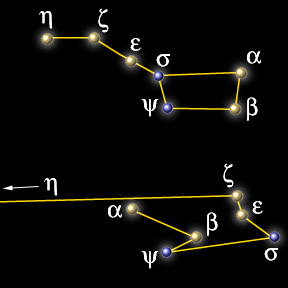This picture shows two different views of the constellation, The Big Dipper. The upper image is what we see from Earth and the lower from a different location in space.
The seven Rishis
According to the epic Mahabharata, composed in about 500 B.C., the stars of the
Big Dipper were the seven sages called Rishis. These seven
sages are said to be those who made the
Sun rise and shine. They were happily
married to seven sisters named
Krttika. They originally all lived together in
the northern sky.
But one day, the god of fire, Agni, emerged from the flames
of an offering performed by the seven Rishis and fell in love with the seven Krttika. Trying to forget his hopeless love for the
Krttika, Agni wandered in the forest where he met Svaha. To conquer Agni's love, Svaha disguised herself as six of the seven Krttika. Svaha could mimic only six of the Krttika
because the seventh sister Arundhati was too devoted to her husband to be imitated.
After a while, Svaha gave birth to a child that she named Skanda. With his birth, rumors began to spread that six of the Rishis' wives were his mother. Six of the Rishis divorced their wives. Arundhati was the only one that remained with her
husband as the star Alcor. The other six Krttika went away to become the Pleiades.
You might also be interested in:
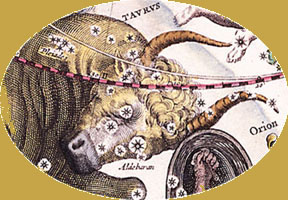
According to the ancient Greeks, the Pleiades were seven sisters. In Greek, the word "pleiades" means "doves." Their parents were Pleione and Atlas who was condemned by Zeus to support the Heavens on his
...more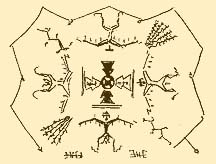
Ahsonnutli was the sky father and chief god for the Navajo. He created heaven, Earth, and the sky. Each of the four directions, or cardinal points, are supported by a giant. Each direction is symbolized
...more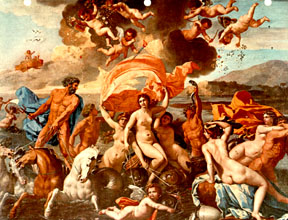
Amphitrite was one of the sea-nymphs called the Nereids. One day the sea god Poseidon saw her dancing and fell desperately in love with her. He promptly asked her to marry him but unfortunately she refused.
...more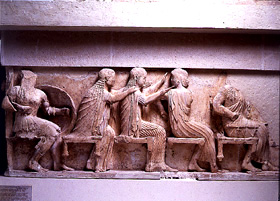
Aphrodite was the Greek goddess of love and beauty. She was known to the Romans as Venus. To the perfection of her figure and the purity of her features she added an innocent grace. On her sweet face she
...more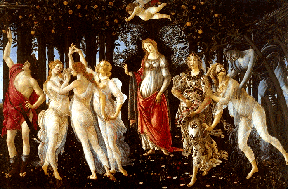
In Greek mythology, Apollo was the son of Jupiter(in Greek Zeus) and Leto (Letona). He was the god of the Sun, logic, and reason, and was also a fine musician and healer. Leto travelled all over Greece
...more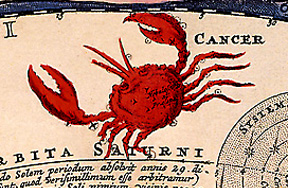
According to an ancient Greek legend, the figure of a gigantic crab was placed in the nighttime sky by the goddess Hera to form the constellation Cancer. Hera swore to kill Heracles, the most famous Greek
...more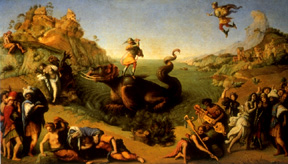
In the Northern Hemisphere sky is the constellation Cepheus, king of Ethiopia, and that of his wife Cassiopeia. Cassiopeia claimed that she and her daughter Andromeda were more beautiful than the sea nymphs,
...more
